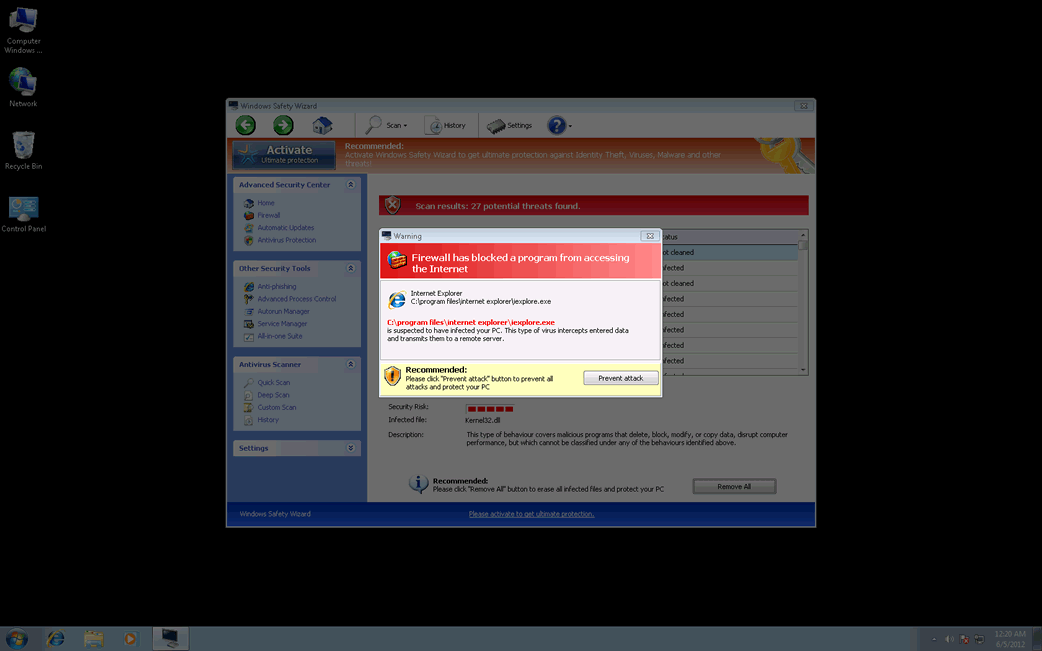Windows Safety Wizard
Threat Scorecard
EnigmaSoft Threat Scorecard
EnigmaSoft Threat Scorecards are assessment reports for different malware threats which have been collected and analyzed by our research team. EnigmaSoft Threat Scorecards evaluate and rank threats using several metrics including real-world and potential risk factors, trends, frequency, prevalence, and persistence. EnigmaSoft Threat Scorecards are updated regularly based on our research data and metrics and are useful for a wide range of computer users, from end users seeking solutions to remove malware from their systems to security experts analyzing threats.
EnigmaSoft Threat Scorecards display a variety of useful information, including:
Ranking: The ranking of a particular threat in EnigmaSoft’s Threat Database.
Severity Level: The determined severity level of an object, represented numerically, based on our risk modeling process and research, as explained in our Threat Assessment Criteria.
Infected Computers: The number of confirmed and suspected cases of a particular threat detected on infected computers as reported by SpyHunter.
See also Threat Assessment Criteria.
| Ranking: | 16,395 |
| Threat Level: | 20 % (Normal) |
| Infected Computers: | 135 |
| First Seen: | June 4, 2012 |
| Last Seen: | July 30, 2023 |
| OS(es) Affected: | Windows |

Windows Safety Wizard Image
ESG malware analysts have classified Windows Safety Wizard as a malware application that should be avoided. While Windows Safety Wizard has the appearance of an actual anti-virus program, Windows Safety Wizard is actually one of the many clones of fake security software in the FakeVimes family of malware. These kinds of malware threats, known as rogue security programs, need to be purchased.
Table of Contents
Windows Safety Wizard and the FakeVimes Family of Malware
The FakeVimes family of malware has been around for a long time; ESG malware analysts have received reports of FakeVimes attacks dating back to 2009. Unfortunately, these malware threats are still at large, and getting more dangerous as time goes on. Windows Safety Wizard and other FakeVimes rogue security programs released in 2012 tend to include a malicious rootkit component that makes them considerably more difficult to remove than previous versions of this malware infection. Some examples of clones of Windows Safety Wizard include Virus Melt, Presto TuneUp, Fast Antivirus 2009, Extra Antivirus, Windows Security Suite, Smart Virus Eliminator, Packed.Generic.245, Volcano Security Suite, Windows Enterprise Suite, Enterprise Suite, Additional Guard, PC Live Guard, Live PC Care, Live Enterprise Suite, Security Antivirus, My Security Wall, CleanUp Antivirus, Smart Security, Windows Protection Suite, Windows Work Catalyst. Despite the fact that they have different names, these are all the same rogue security program.
Windows Safety Wizard and its clones will try to convince their victims that they must purchase a fake upgrade for this useless rogue security program. In order to do that, Windows Safety Wizard has various components that are designed to convince you that your computer system is severely infected with various types of malware. However, if you use the supposed features contained in Windows Safety Wizard's fake interface, they will result in error messages or browser redirects urging you that these nonexistent problems can only be removed with the use of an 'upgraded' version of Windows Safety Wizard. Of course, since Windows Safety Wizard has no actual anti-virus capabilities, paying for a full version of this fake security program is definitely not recommended.
Dealing with a Windows Safety Wizard Infection
To scare you into purchasing its 'full version', Windows Safety Wizard will use numerous error messages, a fake system scan and even block access to your files. You can trick Windows Safety Wizard into thinking that you have registered by entering the code 0W000-000B0-00T00-E0020. While this code will not remove Windows Safety Wizard, it will stop most of its irritating symptoms. However, removing Windows Safety Wizard with a strong, reliable anti-malware application will still be necessary.
Windows Safety Wizard Video
Tip: Turn your sound ON and watch the video in Full Screen mode.

File System Details
| # | File Name |
Detections
Detections: The number of confirmed and suspected cases of a particular threat detected on
infected computers as reported by SpyHunter.
|
|---|---|---|
| 1. | %AppData%\Protector-[RANDOM 4 CHARACTERS].exe | |
| 2. | %AppData%\Protector-[RANDOM 3 CHARACTERS].exe | |
| 3. | %AppData%\NPSWF32.dll | |
| 4. | %CommonStartMenu%\Programs\Windows Safety Wizard.lnk | |
| 5. | %AppData%\1st$0l3th1s.cnf | |
| 6. | %AppData%\result.db | |
| 7. | %Desktop%\Windows Safety Wizard.lnk |

